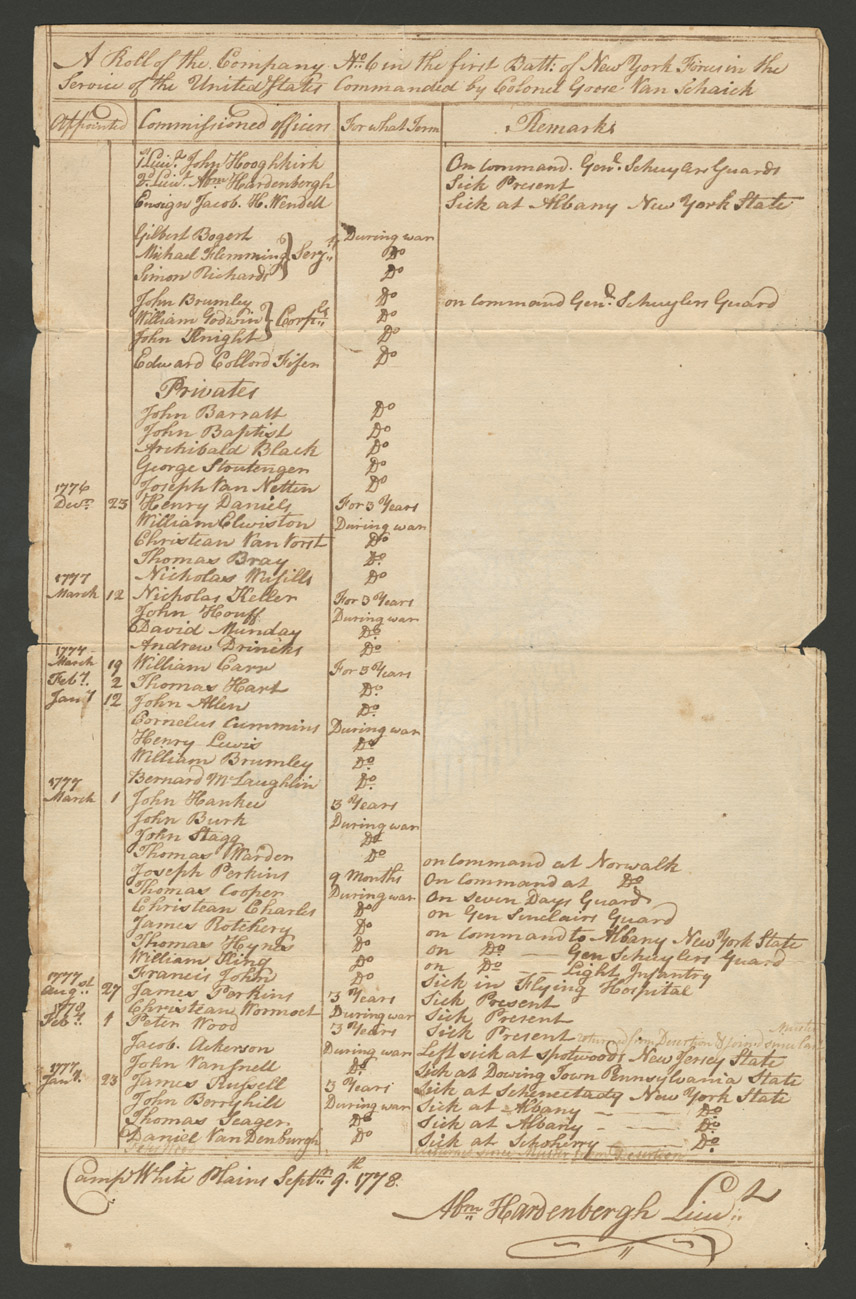Lesson Plan Five: Health and Medicine in Revolutionary America
This site is designed for students to navigate in order to learn about health and medicine during the Revolutionary War Era. It contains a variety of documents, including a diary, a broadside, a diagram, a map, and text excerpts. Each of the three document sets is accompanied by questions and an assignment.
Some documents, for example, the texts from the medical handbooks and the army roster, are significantly more difficult than others, such as the map and the diagram. Depending on the level of your students, you may want to assign different portions of the site to different students, or have them navigate the site in groups so that more advanced students can help weaker readers understand the texts. Another option is to have students focus on only one of the three document sets, then come together in small groups (one from each of the three scenarios) to complete the culminating task together.
Generally, easier texts are listed first within each section. It should also be noted that, while the diary entry alone is very difficult, there is an annotated version available, making it accessible even to weak readers. Additionally, each section includes an extension assignment, which provides further opportunity for differentiation.
Additional Resources
Access the full text of Dr. Buchan's medical here:
http://www.americanrevolution.org/medicine.html
The full text of The Army Medical Department 1775-1818, by Mary C. Gillet is accessible here:
http://history.amedd.army.mil/booksdocs/rev/gillett1/
The site includes pictures, maps, tables, and other resources.
Access the full text of Samuel Sharpe's Treatise on the Operations of Surgery here:
http://www.americanrevolution.org/surgery.html
Read all of Martha Ballard's diary entries and explore a variety of tools for using diaries as primary source documents here:
http://www.dohistory.org/
See an original note for military leave on account of illness here:
Link
Read an official letter certifying half pay for a soldier who lost his arm in battle here:
Link
Read a newspaper advertisement for a 'pleasant medicine' called vegtable syrup here:
Link
Disease and Illness in the Army
Below are ideas and activities related to disease and illness in the army.
Student Instructions
You are a soldier living in close quarters with your comrades. You can't believe how quickly smallpox and other communicable diseases are spreading. Luckily, you've come across a few documents in your commander's tent. Read through them to find out how to keep yourself healthy, and also to learn the fate of your fellow soldiers. (For each of these documents, use your browser's 'back' button to return to this page.)
Read this excerpt from the latest medical handbook to find out what treatment the soldiers are receiving for their fevers.
Read this 1778 broadside to find out what preventative measures are recommended to soldiers in order to stop the spread of disease in the barracks.
Review your company's September 1778 roster to find out what portion of your comrades are ill.
Tomorrow you will see the army doctor. After reading the documents, make a list of questions and concerns you still have about the state of health in your company and what is being done about it, to discuss with the doctor when you see him.
After reviewing the materials, write a letter home to your wife to tell her about your life in the army. Be sure to tell her how many men in your company are ill, what type of treatment they receive, and what measures you are taking in order to stay healthy. Also tell her if you have any concerns about how the health situation might affect the war.
From the second edition of Dr. Buchan’s book Domestic Medicine (1785).
Chapter XV – Of An Acute Continual Fever
. . .
MEDICINE. - In this and all other fevers, attended with a hard, full, quick pulse, bleeding is of the greatest importance. This operation ought always to be performed as soon as the symptoms of an inflammatory fever appear. The quantity of blood to be taken away, however, must be in proportion to the strength of the patient and the violence of the disease. If after the first bleeding the fever should rise, and the pulse become more frequent and hard, there will be a necessity for repeating it a second, and perhaps a third, or even a fourth time, which may be done at the distance of twelve, eighteen or twenty-four hours from each other, as the symptoms require. If the pulse continues soft, and the patient is tolerably easy after the first bleeding, it ought not be repeated.
Excerpt

Excerpt

Battle Wounds / The Wounded Soldier
Discover what would happen to someone wounded in battle during the Revolutionary War in 1776. Find the nearest hospitals, check out the latest surgical technology, and learn what type of treatment he may have received.
While fighting in the Battle of Long Island, your leg was severely injured. The doctors had no choice but to amputate. At the time of the injury, you were located in east Brooklyn. The rapidly expanding medical department of the army is conducting a survey to find out how to meet the needs of the Continental Army. Use the information in the documents below to fill out this survey. It might be useful to print the documents in order to easily reference them while doing the survey.
Use the map of hospital locations in 1776 to find the nearest hospital.
See the diagram and explanation of surgical tools to learn about the latest equipment, used by your doctors.
Read the Excerpt from a medical handbook about surgical procedure to learn about the operation (take notice of whether you received painkillers), and see what kind of training most doctors had (books like this provided training for most doctors - few went through formal medical school).
« Return to Index
